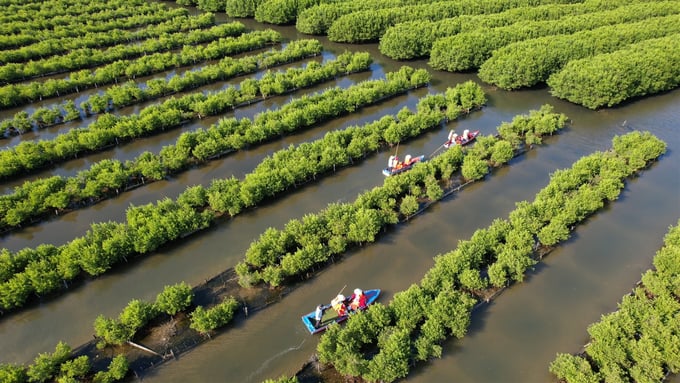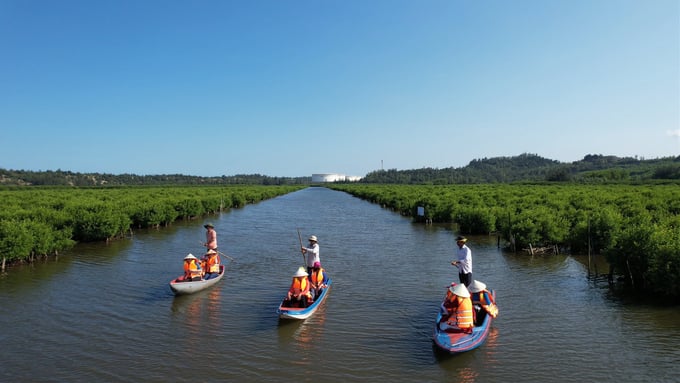June 20, 2025 | 07:42 GMT +7
June 20, 2025 | 07:42 GMT +7
Hotline: 0913.378.918
June 20, 2025 | 07:42 GMT +7
Hotline: 0913.378.918

Bau Ca Cai mangrove forest covers an area of approximately 110 hectares in Binh Thuan commune, Binh Son district, Quang Ngai province. Photo: L.K.
Located in Thuan Phuoc hamlet, Binh Thuan commune, Binh Son district, Quang Ngai province, the Bau Ca Cai mangrove forest covers an area of approximately 110 hectares on a natural lagoon. With its proximity to the sea, Bau Ca Cai has been designated as a protection forest specializing in wave and wind breaking. Over the years, the forest has shielded and protected local villages and residents from major storms.
Bau Ca Cai mangrove forest, with its diverse ecosystem, provides a natural habitat for various aquatic species and a livelihood for the local community. As a resident of Thuan Phuoc hamlet, Binh Thuan commune, whose livelihood has been deeply connected with the mangrove forest for over thirty years, Nguyen Khuong, 67, shared that aquatic species typically follow the water currents to Bau Ca Cai to breed after each flood season. Consequently, the lagoon is populated with shrimp and fish following a flood season.
"As long as local farmers are strong enough, they can earn a few hundred thousand dong daily by setting traps in the forest. The local aquatic species are all considered delicacies, so they have high economic value. Over the years, Bau Ca Cai has nurtured and protected the local residents; thanks to its shrimp and fish populations, families have been able to raise and educate their children. With the current level of local economic development and the establishment of new economic zones, mangrove forests play a significant role in air regulation and environmental improvement," Khuong added.

Beyond its role as a green lung, the Bau Ca Cai mangrove forest has become an attractive community tourism destination for many visitors. Photo: L.K.
However, the progress of climate change in recent years has posed a significant impact on the local mangrove forest area. Namely, the decline of the indigenous Lumnitzera racemosa tree has aggravated coastal erosion and the depletion of coastal aquatic species due to the lack of shelter. In response to this challenges, Quang Ngai province has focused on implementing several restoration and reforestation projects in order to maintain and enhance the role of the Bau Ca Cai mangrove forest.
In the years between 2015 and 2021, the province received approximately 33 billion VND to implement three projects in the communes of Binh Thuan, Binh Tri, Binh Dong, and Binh Phuoc in Binh Son district. Among these projects, the Bau Ca Cai mangrove forest restoration project, coordinated by the Green Climate Fund (GCF) in collaboration with the government and Quang Ngai Provincial People's Committee, has focused on planting several hectares of Rhizophora apiculata Blume, Nypa fruticans and Lumnitzera racemosa. Subsequently, the project has reported positive initial results.
After nearly ten years of concerted efforts from the local government, organizations and residents,the province successfully planted several hectares of new mangrove areas. Complemented by the responsible care and protection of local residents, Bau Ca Cai flourishes to become the green lung for the coastal community. This restoration effort has also revived the natural habitat for aquatic species. Additionally, local residents have invested in farming various species of shrimp and fish, thereby maintaining stable livelihoods and improving income.
Recognizing Bau Ca Cai mangrove forest's potential for ecotourism development, Binh Thuan commune established the Bau Ca Cai Community Tourism Group, with the participation of multiple local households. The group is responsible for creating protection and management mechanisms, setting exploitation limits, and establishing connections with travel agencies in order to design tours and provide instructions to participating households. Additionally, the group has formed task forces to prevent destructive exploitation activities that cause environmental and forest degradation.
Thanks to the local restoration and preservation efforts, Bau Ca Cai mangrove forest has emerged as a captivating destination for both local and international tourists. The development of tourism has revitalized the rural landscape and significantly improved the local community's economy. According to Quang Ngai province's Department of Agriculture and Rural Development, with the aim of further utilizing the advantages of Bau Ca Cai mangrove forest, the province plans to strengthen and integrate various funding sources for the sustainable management, protection, and development of coastal mangrove forests.
Ho Trong Phuong, Director of the Quang Ngai province's Department of Agriculture and Rural Development, stated: "In addition to allocating state budget funds for the management and protection of existing mangrove areas, the province will actively encourage investment and integrate diverse funding sources to promote the sustainable management of mangrove forests, with a focus on conservation efforts and eco-friendly community tourism development. This strategic approach aims to contribute to reinforcing climate change resilience, creating employment opportunities, and providing sustainable livelihoods for local residents."
Translated by Nguyen Hai Long
![Turning wind and rain into action: [9] Digitizing hydrometeorological data in response to climate change](https://t.ex-cdn.com/nongnghiepmoitruong.vn/608w/files/news/2025/06/17/z6704423696987_15fd32ffc26d590d204d520c9dac6786-nongnghiep-165943.jpg)
(VAN) Farmers have begun accessing hydrometeorological applications to adjust their cropping schedules, aiming to ensure productivity and adapt to climate change.
![Turning wind and rain into action: [8] Real-time salinity detection and early warning technology](https://t.ex-cdn.com/nongnghiepmoitruong.vn/608w/files/news/2025/06/17/z6704423696987_15fd32ffc26d590d204d520c9dac6786-nongnghiep-151127.jpg)
(VAN) Thanks to the integration of modern hydrological-hydraulic models, remote sensing technologies, and artificial intelligence, the accuracy of hydrological forecasting has significantly improved.
![Turning wind and rain into action: [7] Early disaster warnings help marine farmers minimize losses](https://t.ex-cdn.com/nongnghiepmoitruong.vn/608w/files/news/2025/06/17/z6704423696987_15fd32ffc26d590d204d520c9dac6786-nongnghiep-142942.jpg)
(VAN) In recent years, thanks to early disaster warnings and forecasting, marine farmers in Khanh Hoa province have been able to reduce risks and losses, thereby improving production efficiency.
![Turning wind and rain into action: [6] ‘Four on-the-spot’ disaster management software](https://t.ex-cdn.com/nongnghiepmoitruong.vn/608w/files/news/2025/06/17/e5a48259d6a262fc3bb3-nongnghiep-183800.jpg)
(VAN) By simply activating the scenario on the disaster management software, the relevant authorities immediately know how many households need to be evacuated, where to evacuate them to, and by what means of transportation…
![Turning wind and rain into action: [5] Hue applies modern technology in disaster forecasting](https://t.ex-cdn.com/nongnghiepmoitruong.vn/608w/files/news/2025/06/17/z6704423696987_15fd32ffc26d590d204d520c9dac6786-nongnghiep-093938.jpg)
(VAN) In Hue city, modern technology has recently been applied in meteorological and hydrological forecasting and warning, helping to reduce the damage caused by natural disasters.

(VAN) A cutting-edge farming technique being implemented on an experimental ranch in Arizona's Sonoran Desert has already saved a billion gallons of water over five years, according to Civil Eats.

(VAN) Poultry and pig production and the environment can be boosted through enhanced water technology, according to new research.